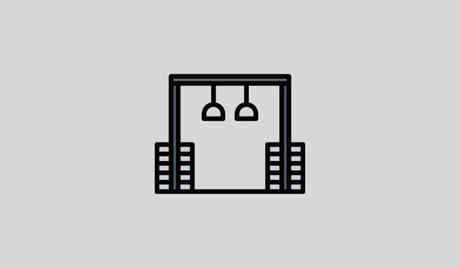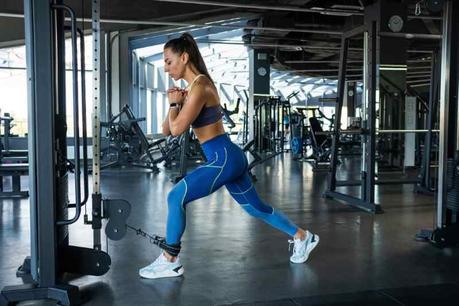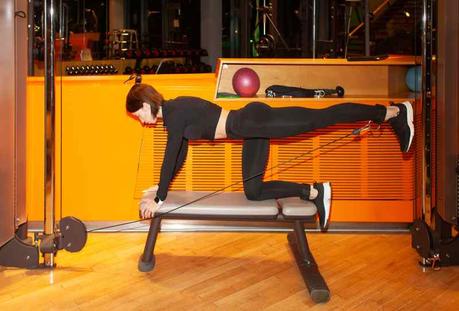Take leg day to the next level with these five cable leg exercises, including the benefits of training legs with a cable machine and a sample 20-minute workout.

Building those thicc thighs and legs isn’t easy!
It takes long hours of training, really hammering away at those legs, to develop the powerful quads, hamstrings, and glutes that will give you the serious lower body power you want.
Free weights, dumbbells, kettlebells—they’re all brilliantly useful to incorporate into your training sessions. But nothing can ever truly beat the cable machine.
It all comes down to “time under tension” (which I’ll explain below), which maxes out muscle growth and hypertrophy.
If you want MASSIVE legs, take the time to read the list of cable exercises for stronger legs and glutes below, and go over our quick-and-dirty workout to find the best newest additions to your Leg Day training sessions.
Are Cable Machines Effective for Training Legs? ( )
)

Cable machines offer a truly next-level solution for leg- and glute-training for a few simple reasons:
 Lots of options!
Lots of options!

Thanks to the many cable machine attachments that are available along with the cable machine, you’ve got many different solutions for working out your legs.
Use the regular D-rings or handles for squats, fasten on the ankle straps for kickbacks and donkey kicks, and so much more.
In this regard, cable machines are far more versatile than your basic free weights.
 Greater time under tension.
Greater time under tension.

With free weights, you typically reach a “resting point” where the weight is supported without the need for your muscles to engage. For example, when you reach the top of a bicep curl, the structure of your elbows and wrists bears the weight, giving your muscles a moment to relax.

The same at the bottom of the curl, when it’s hanging at full arm extension.
But not so with cables! The system of pulleys and cables keeps your muscles under tension through the entire range of motion, so there’s never a time when your muscles “relax” between reps.
This greater time under tension leads to significantly faster muscle fatigue and failure, which helps to trigger growth during recovery.
 Easier to focus on form.
Easier to focus on form.

Because you’re not actually carrying any weight, there is far less strain placed on your body to draw your focus.
This allows you to pay full attention to the way you move through each rep, helping you to master the correct posture and form in every aspect of the movement.
Beginners will love cable machines for this reason. They’re also much safer and far less likely to cause injury than with free weights.
 No spotter needed.
No spotter needed.

With free weights, you’ve got to carry the load all by yourself, so ultra-heavy weights may be too much to work with unless you’ve got a spotter for backup.
But with cables, there’s no need for a spotter. If you’re struggling and just can’t hit that final rep, it’s safe and easy to lower the weights back onto their rack without risking muscle or joint injury.
Solo gymgoers will find it a great alternative to the standard free weights.
 More efficient.
More efficient.

No more time wasted stacking weight plates or collecting/returning dumbbells. It just takes two seconds to insert the pin to set the cable machine to your desired weight, and you’re ready to get working!
As you can see, there are a lot of great reasons to incorporate cable machines into your workouts.
You don’t have to make the entire training session cable machine-based, but mixing in at least a few exercises (like those we’ve listed below) will add variety enough to not only prevent workout boredom, but take your training sessions to the next level.
Cable Exercises for Stronger Legs and Glutes
 Exercise #1: Cable Squats
Exercise #1: Cable Squats

If your goal is to build powerful legs, you’ve got to start with your quads! The four muscles in your thighs are the largest lower body muscle group, which means they’ll not only grow fastest in size, but also in strength.
And, of course, nothing builds quad power like squats. Adding in the cable machine just makes the squats that much more effective!
To perform this exercise:
- Set the cable machine to the lowest setting, and secure regular handles to the cable.
- Stand between the cable machine with your feet spread roughly shoulder width apart, toes facing forward (or pointed slightly outward), and your spine straight.
- Grab the handles and, while standing, bring them up to roughly shoulder height. Keep your elbows bent and tucked into your sides, which will help to reduce the strain on your upper body.
- Squat. Descend slowly, controlling your movement, and lower until you reach a 90-degree angle, with your thighs parallel to the floor.
- Hold for a 1-count, then slowly stand. Once you reach the “top” (upright position), thrust your hips forward to increase glute engagement. After a 1-count pause, squat again.
- Repeat as desired.
 Exercise #2: Cable Hack Squat
Exercise #2: Cable Hack Squat

This is an interesting variation on the standard hack squat. Instead of using the hack squat machine (or Smith Machine), you can instead use the cable machine.
You’ll have to adapt the way you approach the squat, but if done right, it can be an excellent bodyweight movement to help you master the hack squat.
See also: Hack Squat Foot Placement: 7 Positions and the Benefits of Each
To perform this exercise:
- Stand facing the machine with your feet planted together. Stand roughly 18 inches away from the machine.
- Grip the straight-bar or V-bar attachment, with the handle set on the level of your feet. Bring the handle up to your chin/chest and hold it there.
- Bend at the knees and hinge your hips to squat. Focus on leaning back against the weight pulling on the handle. This will help you to perform a hack squat, which will feel a lot like sitting down in a chair (chair squat).
- Stop once your knees reach a 90-degree angle, and hold for a 1-count.
- Drive your heels into the ground and push back upward until you reach a standing position.
- Repeat as desired.
 Exercise #3: Cable Lateral Lunge
Exercise #3: Cable Lateral Lunge

While squats and forward/backward lunges focus on the larger medial muscles in your legs, you’ve also got to pay attention to the lateral muscles. These help to support your hips and enable effective, efficient side-to-side movement.
Which is where the cable lateral lunge comes in! This exercise is guaranteed to help you develop greater power in the gluteal, hamstring, and quad muscles that will have you running and jumping laterally like a true athlete.
To perform this exercise:
- Start with the cable machine on your left side, gripping the handle in your left hand. Set the machine at the lowest level (ankle level).
- Step your right foot out to your right. Aim for a “big step” (unspecified distance, but whatever feels comfortable for your hips).
- Once your foot is planted, bend at the knee and lower into the lunge.
- Stop once you hit the 90-degree angle, and hold for a 1-count.
- Push back up from your lunge, then push backward to return to your original position.
- Repeat for the desired number of reps on the right side, then switch to repeat on the left.
Trainer’s Note: This exercise is game-changing to help improve your balance and stability!
 Exercise #4: Cable Step-Ups
Exercise #4: Cable Step-Ups

Step-ups are excellent for building every one of your leg muscles!
Through the step-up and step-down movements, you hit your glutes, hamstrings, thighs, and calves, leading to overall stronger legs.
(Step-ups are also one of the best dumbbell exercises you can do for stronger glutes.)
Plus, it will target the muscles specifically supporting your knees, making this (typically vulnerable) joint significantly stronger and more injury-resistant.
To perform this exercise:
- Place a step-up box directly in front of the cable machine. Set the handle to the lowest level (ankle-level) and select your desired weight.
- Grab the handle in both hands and bring it up to chest level, where you will hold it throughout the workout (for great additional upper-body exercise!).
- Step your right foot forward and up onto the step-up platform or box. Push off your left foot to propel yourself upward. Plant your feet side by side, and hold for a 1-count.
- Step your right foot backward and down onto the floor behind the platform/box. Use the power in your left quads to lower slowly and under control. Lower your left foot, plant it next to your right foot, and hold for a 1-count.
- Repeat for the desired reps on the right side, then switch feet to repeat on the left side.
 Exercise #5: Donkey Kicks
Exercise #5: Donkey Kicks

This is an amazing exercise for targeting your glutes! You’ve already hit your glutes using the squats, lunges, and step-ups, but this one is all about making those butt muscles BURN.

Add this in as a “finisher” to the end of your leg workout, and you’ll walk away feeling like a million bucks.
To perform this exercise:
- Secure the ankle strap to the cable machine, and strap it around your right ankle.
- Stand facing the machine, but far enough back that when you bend forward at the waist, you can extend your arms to support your balance on the machine’s frame.
- Bend your legs slightly at the knee. Shift all of your weight onto your left foot.
- Kick your right foot up and behind you. Keep raising until your leg reaches your hip level (full extension), and lower it under control back to your starting position.
- Repeat this kicking-behind-you motion for the desired reps, then switch the ankle strap to your left foot and repeat to complete the set.
20-Minute Cable Leg and Glute Workout
Combine these five exercises I’ve listed above into one leg-focused cable machine workout, and you’ll shred serious muscle and get through an intense workout in no time!
Cable Squats – 4 sets of 8-12 reps, with 30 seconds of rest between sets.
Cable Hack Squats – 2 sets of 8-12 reps, with 30 seconds of rest between.
Cable Lateral Lunges – 3 sets of 8-12 reps, with 30 seconds of rest between.
Cable Step-Ups – 3 sets of 8-12 reps, with 30 seconds of rest between.
Donkey Kicks – 3 sets of 8-12 reps, with 30 seconds of rest between.
As always, make sure you warm up your legs properly and add some post-workout glute stretches to help speed recovery and increase range of motion.
Cable Leg Exercises – FAQs
Can I do squats with a cable machine?
Absolutely! The great thing about squats with a cable machine is that there’s no load placed on your core/upper body.
You don’t have to support a barbell or carry two dumbbells, so the focus is almost entirely on your lower body. You’re far less likely to exacerbate an existing back injury or strain your neck/shoulder/upper back muscles under the weight of a heavy load.
But the cable machine still lets you add weight to your squats, so you can push your legs to the absolute max and see real results.
Can you build leg muscle with just cables?
You definitely can. You can certainly focus entirely on cable machine workouts (to the exclusion of free weights and other machines) and see real muscle growth. Because of the increased time under tension, the growth may even be accelerated, helping you to pack on the muscle.
However, it’s a good idea to keep your workout as varied as possible, mixing in a variety of machines and free weights rather than just focusing on one. That way, you get the most natural, functional muscle development possible.
The Bottom Line
Take these cable machine leg and glute exercises to the gym with you on your next workout, and you’ll feel a serious difference!
The increased time under tension and the reduced load on your body will be game-changing.
You’ll walk away from your workout with your legs pushed to the point of exhaustion, and the muscle growth will be visible in no time at all.
More Cable Machine Guides

5 Cable Chest Exercises for a Strong Upper Body (Plus a 20-Minute Chest Cable Workout). Ready to level up your chest workout? Here are the essential cable chest exercises for building a stronger, more muscular chest.
